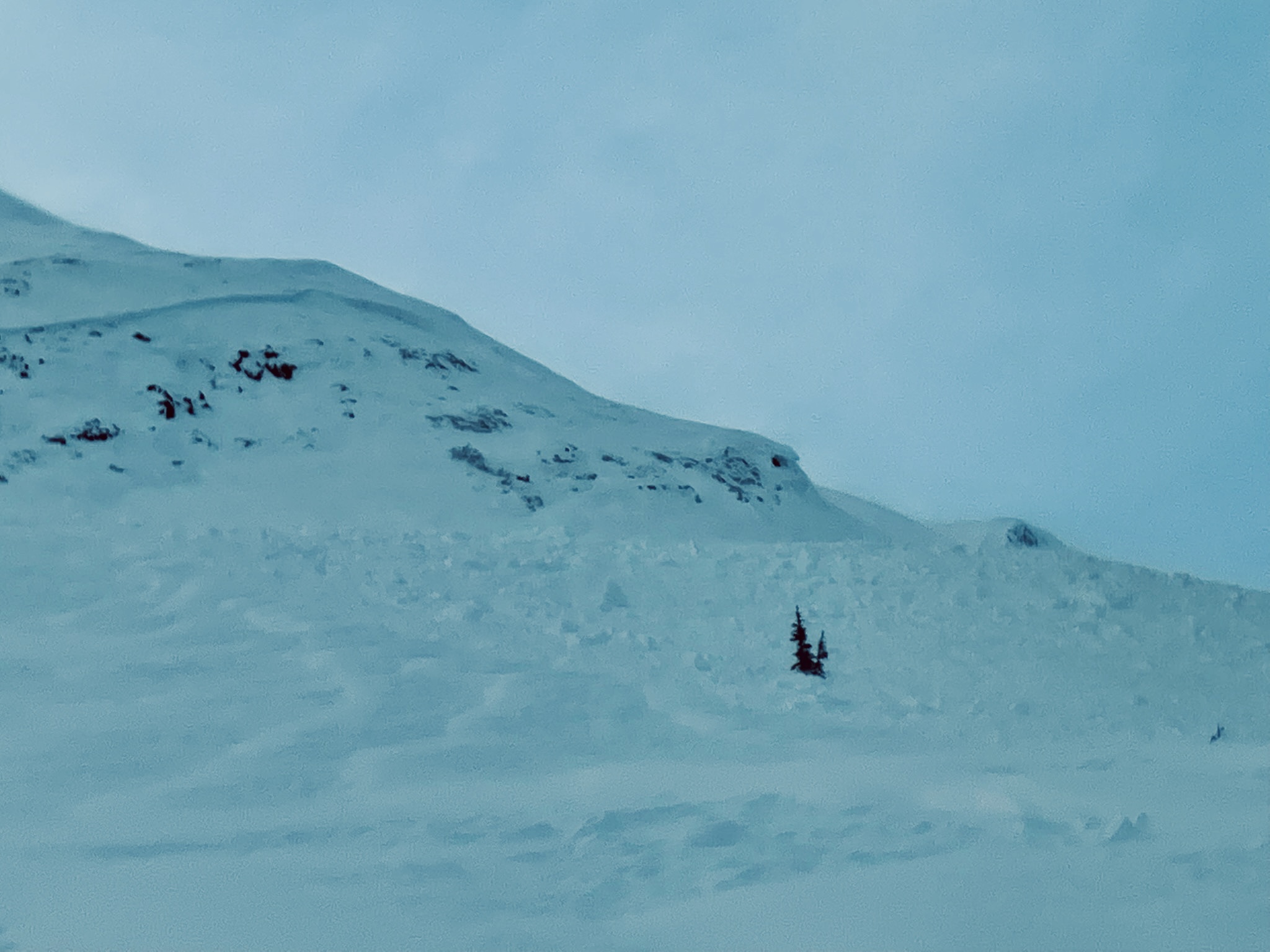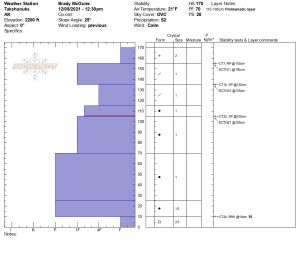Haines Avalanche Center
Above 2,500ftModerate
1,500 to 2,500ftModerate
Below 1,500ftModerate
Degrees of Avalanche Danger
Avalanche Problems
Problem 1
Aspect: Most likely on wind loaded aspects and features SW-S-SE-E.
Elevation: Mainly at and above treeline.
Strong NW winds over the last several days caused new wind slabs to build in the alpine. You will find a lot of variability out there, and loaded areas (especially below ridgelines and in couloirs/gullies) may have multiple feet of recent slabs with weak layers in between. If a wind slab is triggered there is still some potential for it to step down to deeper weak layers and cause a large avalanche.
Identify wind-drifted snow by looking for stiff or hollow surface snow, and looking for cracking, whumphing and blowing snow – treat these areas as highly suspect. You can find safer conditions in wind-protected areas with softer snow.
Likelihood:
- Almost Certain
- Very Likely
- Likely
- Possible
- Unlikely
Size:
- Historic
- Very Large
- Large
- Small
Trend
- Increasing
- Steady
- Decreasing
Problem 2
Aspect: All aspects.
Elevation: All Elevations.
Cold weather will only serve to weaken buried layers. The persistent slab danger is not healing, it is standing by waiting for the right trigger. Don’t be the trigger!
Recent stress tests have unearthed layers of concern that have propagation propensity and the potential to step down into deeper layers of the snowpack.
Persistent avalanche problems are tricky. The question is: When will stress over-ride strength and cause a slab to fail?
- Cold temperatures Dec. 3-5 created weak snow at the surface that is buried in many places under a strong wind slab in the upper snowpack.
- Over a meter deep: old weak layers are buried and difficult to trigger but still reactive.
- Toward the very bottom: early season snowfalls and crusts linger and are very difficult to trigger but are still of concern.
It is still possible that any surface avalanches could step down to deeper weak layers, the October rain crust, or even the ground in alpine areas.
- One of the best ways to reduce your exposure to deeper persistent weak layers would be to stick to areas of deeper snowpack (>1m deep). But be wary of hidden rocks that can act as trigger points, and thin areas around the margins of a slab.
- Manage the terrain by only exposing one person at a time to the hazard, use group up spots well out of harms way, and carry radios for communication.
- Look and listen for whumping, and other signs of instability. Report any natural avalanche activity on these deeper layers.
Likelihood:
- Almost Certain
- Very Likely
- Likely
- Possible
- Unlikely
Size:
- Historic
- Very Large
- Large
- Small
Trend
- Increasing
- Steady
- Decreasing
Avalanche Activity
This natural avalanche occurred on Dec 11th on Old Faithful during the recent wind event. It ran on a cross-loaded NE aspect at 3200ft, running on the October rain crust. It shows that given a heavy new load, this persistent weak layer can activate and cause a large avalanche.

Weather
The NW winds will decrease today, and clouds increase as a quick shot of light snow comes in by tonight.
- A strong NW wind event began on Saturday, causing active wind loading
- Early December has brought in about 2-4 feet of snowfall
- November brought consistent heavy snowfalls, cold weather, and SE winds
- October brought heavy snow in the alpine, followed by a few rain/sun crusts
| Snow Depth [in] | Last 24-hr Snow/SWE [in] | Last 3-days Snow/SWE [in] | Today’s Freezing Level [ft] | Today’s Winds | Next 24-hr Snow/SWE | |
| Mount Ripinsky @ treeline ** | 65″ | 0″ / 0.0* | 0″ / 0.0* | 0′ | light, NW | 2″ / 0.10* |
| Flower Mountain @ treeline | 46″ | 0″ / 0.00 | 0″ / 0.0* | 0′ | light, NW | 1″ / 0.05* |
| Chilkat Pass @ 3,100ft | 20″ | 0″ / 0.00 | 0″ / 0.0* | 0′ | light, NW | 0″ / 0.00* |
( *star means meteorological estimate )
** The Ripinsky weather station is in need of repair, and will likely be down until Summer.
Additional Information
Be prepared for an emergency and hypothermia. Winter is a high consequence environment. Carry bear spray.
Become a sustaining Haines Avalanche Center Member by clicking the poster or visiting dev.alaskasnow.org/joinHAC. Support local forecasts, observations, education and weather stations. Join a community of winter recreationalists. Benefit from collective knowledge and skills. Help keep your friends and family safe in the backcountry. Get a free limited edition mountain buff, or neck gaiter with a $50 membership (first 20 members!).
Practice like you play. Make sure all your rescue gear is fully functional and your beacon has NEW batteries. Make sure 1) everyone in the group has a functioning beacon, shovel and probe 2) knows how to use them and 3) has trained in companion rescue in the last year. Keep your skills fresh. If you head into the hills, watch out for red flag avalanche conditions, natural avalanches, whoomphing or collapsing, and shooting cracks.
Education Video Links:
- AIARE
- How to Practice Avalanche Rescue Snowmobile Edition: https://youtu.be/2ML499MMDfM
- AK Sled Shed Motorized Learning:
- Intro: https://youtu.be/aoagKHfGkxs
- Personal Electronics in Avalanche Terrain: https://youtu.be/2Vz9S0OEyFk
- Snowmobile Macgyver Tool Kit: https://youtu.be/4WBNu_t6Bbk
- Head and Face Protection: https://youtu.be/jIzW89wOyZI
- Pre-season prep: https://youtu.be/zJmrb8cZlR4
- My Transceiver: https://youtu.be/yblaDWP7Jf8
- BCA Avalanche Safety for Snowmobilers
- How to Fix Common Snowmobile Problems in the Field: https://youtu.be/g9fiTxEvuFk
- Sleducation: Avalanche Safety for Snowmobilers: https://youtu.be/EWFOd_9DYb8
- Intro to Avalanche Transceivers for Snowmobilers: https://youtu.be/6ZLSBmsceog
- Avalanche Transceiver Trailhead Test for Snowmobilers: https://youtu.be/rWoXbadFBsY
- Avalanche Transceiver Searching Use Snowmobiles: https://youtu.be/w1ucyI6LMXM
- BCA Avalanche Rescue Series
- Beacon Search 101: https://youtu.be/nnHXLVA2FcE
- Avalanche Probing 101: https://youtu.be/-0_yDN5Drzw
- Avalanche Shoveling 101: https://youtu.be/dGQg9o3vAkM
- Organizing a Backcountry Rescue: https://youtu.be/gywtmukgt8s
- Post Avalanche Patient Care: https://youtu.be/9FyIeUy4wpQ
- Backcountry Evacuation: https://youtu.be/WPF-dciefL8
- Complex Multiple Burials Backup Techniques: https://youtu.be/pB6AfY2KyYo
- National Avalanche Center
- Avalanche Problems Explained: https://youtu.be/DkbnT_9-cHU
- Intro to North American Avalanche Danger Scale: https://youtu.be/r_-KpOu7tbA
Announcements
Thursday, Friday, Saturday and Sunday forecasts have begun. Click the –Full Forecast– button below for more details. Please submit your observations!






